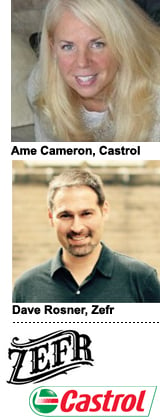 It’s hard to drive deep engagement with motor oil.
It’s hard to drive deep engagement with motor oil.
“Oil is just something people aren’t naturally interested in,” admits Ame Cameron, head of US brands and communications at BP Castrol. “I think people have a lot of questions about it, but it’s probably one of the least sexiest categories in the world.”
With that reality in mind, Castrol, a motor oil brand owned by British company BP, wanted to target its high-performance product Castrol Edge to hard-to-reach male gear heads and DIY fixer-uppers.
Castrol had made feature-like films and TV ads, but it wanted to push its video strategy beyond just two 30-second ads a year. This shift led the brand to experiment with a mix of digital creator and long-form video content, marking its first foray into the influencer marketing space.
Castrol used the video technology Zefr to identify an influencer named Grant Thompson, who makes popular life-hacking videos.
It was an unusual move for an engine oil brand to get involved in influencer marketing to begin with, said Dave Rosner, Zefr’s strategic marketing EVP.
“You don’t expect a motor oil brand to say to an influencer, ‘Please freeze, boil and explode my motor oil to bring my activation to life,’” Rosner said.
But one of Zefr’s focuses is bringing “more discipline,” as Rosner describes it, to the historically relationship-driven (and data-lacking) influencer business.
Besides the influencer content produced by Thompson, which generated 1.5 million views with an average watch time of four minutes, Castrol used Zefr’s BrandID to target a long-form video to DIY, auto, sports and certain politics segments.
That video used Google’s skippable ad format, TrueView, and generated 1 million views for content that was more of an informational product demo than viral stunt.
Castrol wanted to use TrueView formats because they were tailored more toward viewability, since it didn’t amplify its influencer content.
The oil company mainly aimed for success metrics such as shares, likes, views and average view time, but its ultimate measure of performance is brand health. So it was paramount Castrol be precise in its targeting to reach a receptive audience in the first place.
“You’ll find audiences who go well beyond the view-through if they’re engaged with the content, so you can start to move into deeper metrics like loyalty and purchase intent,” Rosner said. “Those are the metrics most brands want, and they use the media metrics as a barometer to try and [influence] business metrics.”
Although Castrol thought the campaign results were positive, it’s aware of the challenges of engaging in influencer marketing.
Grant Thompson’s video may have incorporated the label “#ad,” but brands face growing regulatory pressures around insufficient disclosure of celebrity endorsements and sponsorships, mostly because it’s tough to define what qualifies as proper disclosure.
Castrol’s Cameron likens the brand’s influencer-activated video to early promotional product placements in television. She says it should serve a purpose and be augmented as part of the native storyline or program.
“The main reason people want to work with a key opinion leader [like Thompson] is because they know their audience,” she said. “It’s a balance, because you’re essentially endorsing them and of course they’re ultimately delivering an ad. But working with [an influencer] effectively let us bring a product demo to a campaign, but in a really innovative, breakthrough way.”
Castrol’s next campaign steps will include branching out beyond the low-hanging fruit in demographics (males 18-35) and incorporating women or other markets.






 By
By 